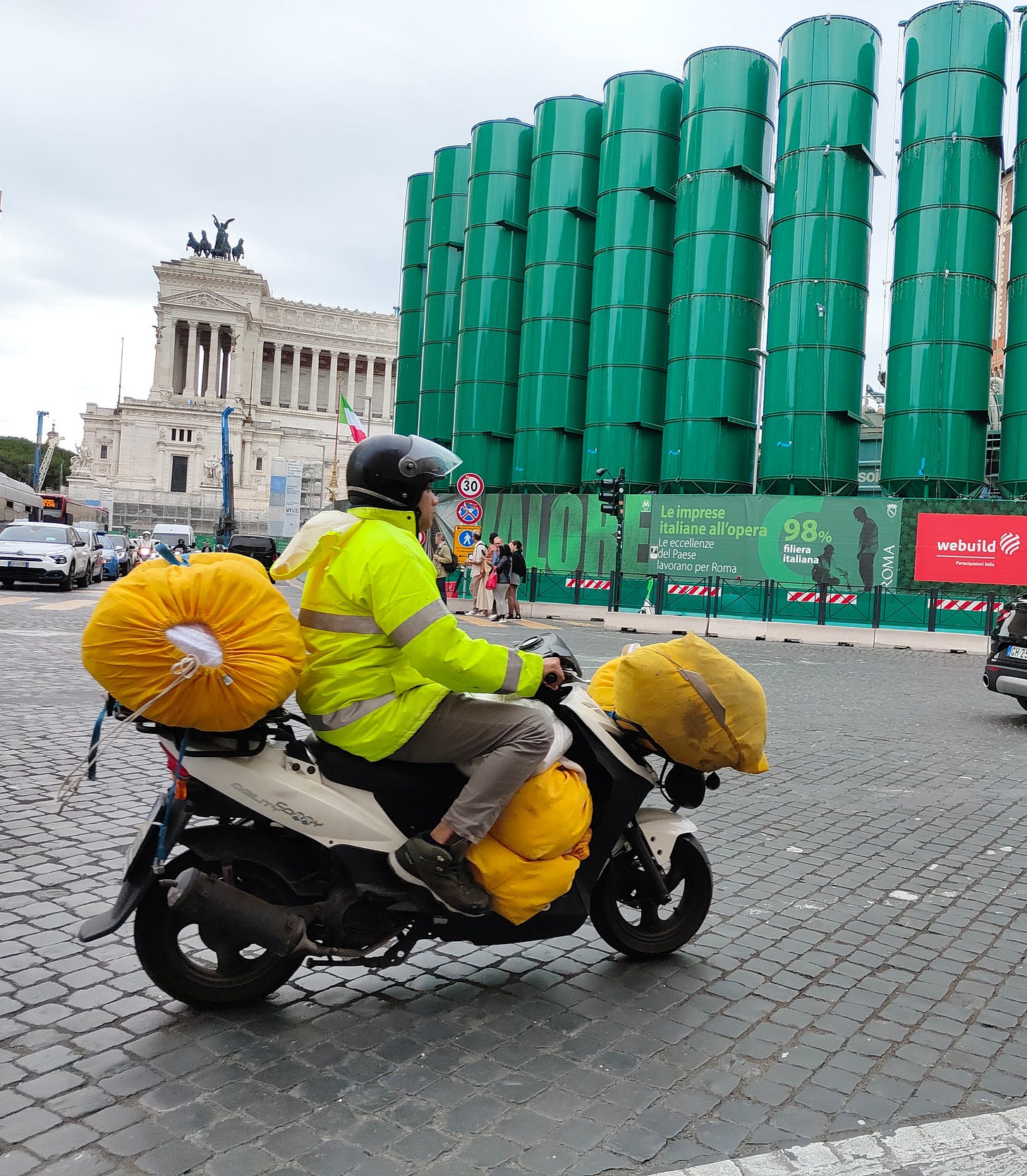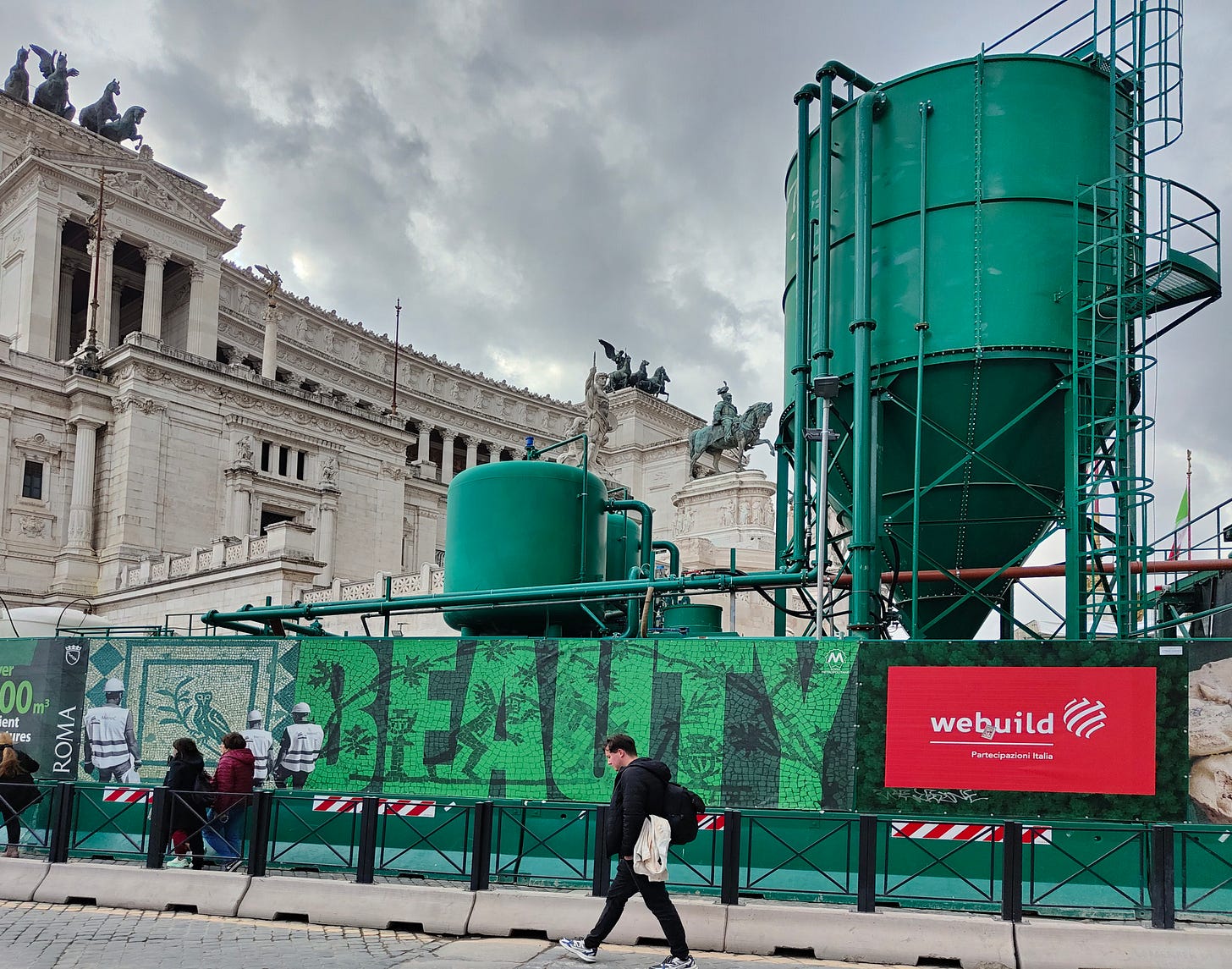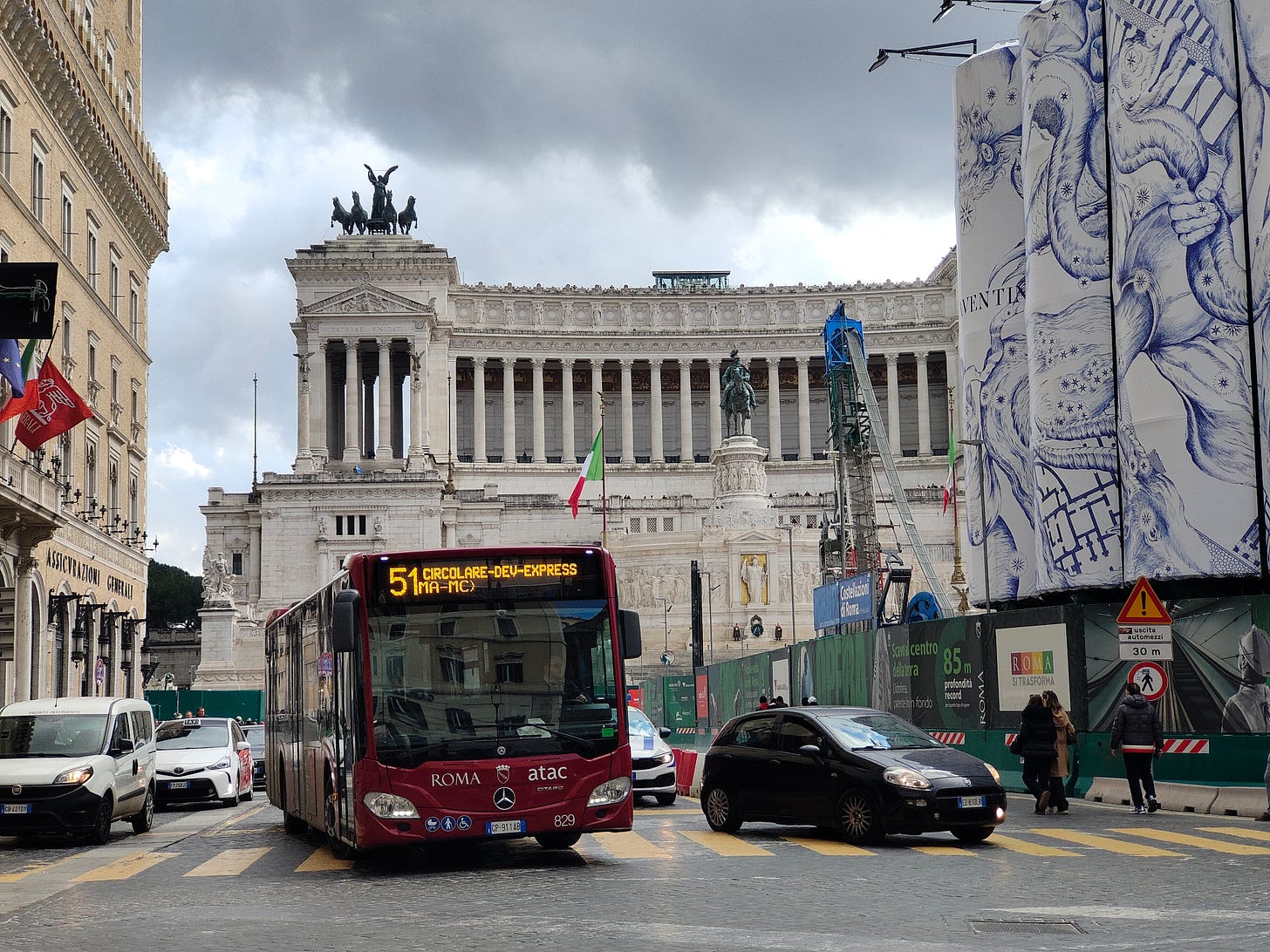The biggest cover-up in Rome: Pietro Ruffo takes on the silos of Piazza Venezia.
The Metro C station under construction in Piazza Venezia is digging down into centuries of Roman history. How to deal with a construction mess that will last until 2033?

Piazza Venezia is for me like an unforgiving urban magnet. Ever since I first came to Rome as a fledgling Fulbright scholar, Piazza Venezia intruded into my daily routine. I had to traverse the square countless times, risking life and limb each time I tried to cross one of the most chaotic traffic circles in Europe. When I finally got myself a Vespa, my Roman friends would roll over laughing when I described my harrowing experiences driving around among the swarms of busses, taxis, cars, motorcycles, bicycles and frightened pedestrians that circled the meagre green patch in the center of the piazza. If there was a real lifesaver, it was the hydraulically powered cylindrical traffic podium that could rise discreetly above the pavement, offering enough room for one police officer to orchestrate the flow of the traffic with his or her strategic hand gestures. This podium in Piazza Venezia was so absurdly unique that it spawned a whole sub-genre of Italian comedy.

But these familiar scenes of chaos would forever change once the Metro C line, the capital’s newest underground transportation project, began cutting through Rome like a sandworm from Arrakis. Work on Metro C broke ground in 2008, and by now its possible to get from Rome’s southwestern periphery to San Giovanni which is now conveniently connected to the Metro A line. As work progresses, and barring any further significant archaeological discoveries, the C should reach the Colosseum station by the end of 2025, finally making the connection to the B line.
Getting the C line to the Colosseum, after years of delays, would surely have satisfied even the most ardent of subway riders, as all three subway lines would finally be within reach. But with new money and energy, the C line’s original goal, to reach Saint Peter’s across the Tiber and then beyond to North Rome is again back in play. The net effect, however, is like shoving an upside down colosseum 45 meters underground into the heart of Rome. The Metro station in Piazza Venezia is intended to plug a colossal transit hub into what is in effect a most fragile and ancient cityscape. Metro C Venezia Station will feature four underground decks, dozens of serpentine public passages and a permanent display of excavated artifacts. The only catch is how long this thing is supposed to go for: the earliest date set for the opening is 2033.

So the city has a pretty good mess on its hands. Piazza Venezia serves as a street level hub where 5 major roads intersect: the capital’s principle street, the Via del Corso, which follows the ancient via Flaminia, heads straight down from Piazza del Popolo—the historic gateway to Rome. When the Via del Corso reaches Piazza Venezia it meets a lateral artery that snakes down from the train station Termini, the Via Nazionale, and then continues along the via del Plebiscito to Trastevere, the neighborhood especially popular with English and American tourists.

If you had dared to stand against traffic at the end of Via del Corso before work on the Metro C had begun, you would have gotten the full view of Piazza Venezia, framed by the massive Vittoriano, the white wedding cake monument with statues and sculpted reliefs, twin bronze chariots, flagstaffs and fountains plastered all over it. The Goddess of Rome stands just above the monumental flight of stairs, hovering over the Altar to the Fatherland, where the Eternal Flame burns flanked by two soldiers. The structure also includes the Shrine to the Unknown Soldier, a museum to the Risorgimento in the basement, and a library in its top level. And of course what would a monument to King Victor Emmanuel II be like without a bronze representation of him on a horse leading the nation. Little importance that the King’s family thought the monument unworthy of the King himself, whose actual tomb is located in the Pantheon.

If you manage to make it up to the Vittoriano, then you will see the Via dei Fori Imperiali as it connects to the Roman Forum and the Colosseum. Nonetheless, this is not the first time such a major transformation has turned Piazza Venezia into a massive construction site. The piazza has been worked and reworked since construction on the Vittoriano first began at the turn of the 19th century. Entire historic neighborhoods were cleared to make way for this monumental extravagance, war bunkers were buried underneath the square, massive parades and rallies organized by Mussolini and the Fascist party took place here. After the war, the piazza became a symbol for the new Italian republic, with annual air-force flybys, national ceremonies and political demonstrations.

Yet among all this metro station confusion someone had the brilliant idea to cover-up the ten immensely ugly green cement silos that loom above the construction site. All of sudden there is the chance to take advantage of all this ongoing chaos to make something different happen right smack in the middle of Rome. The art project, “Murales,” sponsored by “webuild,” invited 6 artists, Elisabetta Benassi, Liliana Moro, Pietro Ruffo, Marinella Senatore, TOILET PAPER and Nico Vascellari to invent a succession of projects covering the silos. The first one up is by Pietro Ruffo, titled “the Constellations of Rome, which covers the 10 meter high 65 meter wide set of linked silo structures with a huge printed plastic sheeted mitten. Ruffo wrote, “Rome, in its history, has grown arm in arm with artists; but it is as if at a certain point this love story was buried. And now the fact that people think it could be a good idea to insert contemporary art into a modern subway construction site is not a given; it is a beautiful sign, also political, because it takes up what had always been done, but was no longer done.”

The Scientific Committee charged with overseeing this outdoor project is made up of members form the Galleria Nazionale di Arte Moderna e Contemporanea (GNAM-C) the Galleria Borghese, MAXXI, and the Palazzo delle Esposizioni. This latter arts institution on Via Nazionale is currently hosting a major exhibition, The Last Marvelous Minute, by Pietro Ruffo, that goes a long way in explaining the way Ruffo thinks and creates his fantastical imagery. Its a kind of ode to nature and the relatively brief but rich human history. And it drags along with it some kind of deeper notion on the Anthropocene. Lets hope that in 2033, when the Metro station Venezia will finally open to the public, the world outside will still be livable and hopefully still be enjoyable for us all.




